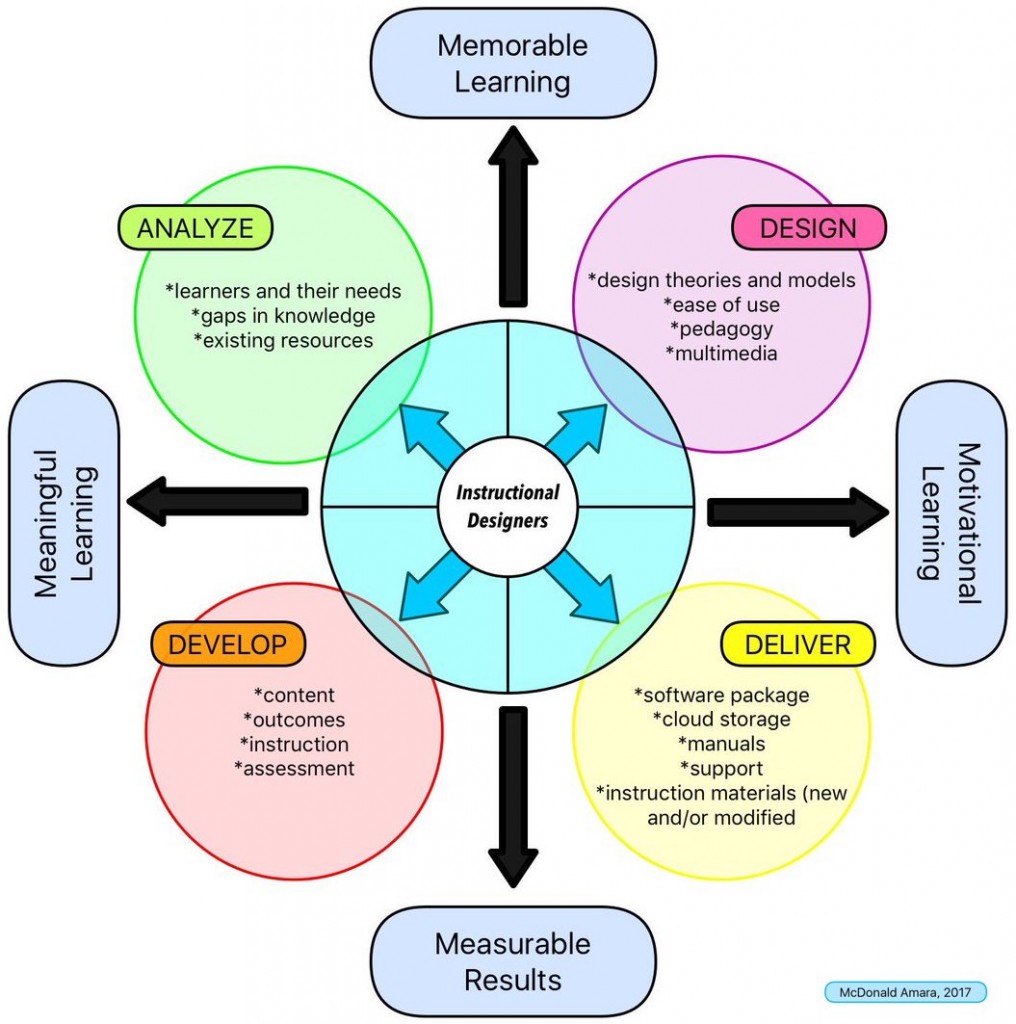Designing Courses with ID in Mind

Today’s teachers have a number of tasks that were not necessarily part of their domain years ago. Often, one of those tasks is designing courses, which some teachers can find overwhelming. A few weeks ago, a faculty member asked for some guidance, saying, “I’m not an instructional designer; how am I supposed to know how to create a course?” I assured her that, while it’s true a lot goes into becoming an Instructional Designer (ID) and that designing entire courses is based on a combination of research, theory and best practice, there are a number of instructional design principles that can easily be kept in mind when non-ID teachers are putting courses together.
The ID Role
In a nutshell, the role of an ID is to analyze leaners and their needs by identifying gaps in their knowledge, design resources and materials to meet those needs, develop courses using content and the supporting material, and deliver the courses in their entirety (think software packages, user manuals, instruction materials, and so on), all followed by stages of evaluation and adaptation.
The Teacher’s ‘ID’ Role
All of that may sound like bit much for a teacher’s schedule to handle and, in truth, it is. It doesn’t mean, however, there aren’t elements of the process that can help teachers construct courses that benefit leaners and have the added bonus of saving teachers valuable time; if courses are designed well and offer a variety of supports, learners will have 24/7 access to learning and support materials that can save teachers from answer the same questions dozens of times.
Probably the biggest and most important part of the process here is the analysis phase; if that foundation isn’t solid, anything built on it will not hold up. In a formal ID process a lot of work and research might go into analyzing learners and their needs. Teachers may not have the luxuries of time and opportunity to do this, but they can start at the other end and analyze the course objectives. They can also review the course objectives of any prerequisite courses to create review material to support new learning, as well as those of any corequisite courses to find useful overlap. Also consider any technology the learners will have access to such as personal devices, labs, blended or online learning environments and so on. How much time do you have to deliver the course? Think about holidays and reading weeks.
The next phase of ID is designing materials to support the analysis, which is something a lot of teachers enjoy. This doesn’t have to be endless pieces of high-tech support. Based on the professional development we get at HCT, this can be a simple mix of uploaded PDFs, Nearpod lessons, practice quizzes, Padlets, Kahoot! challenges and several multimedia options such as embedded videos and audio files. It’s just important to remember that anything you create to support learning has to be based on the analysis; anything that isn’t will fall short of the mark.
The final step for teachers is to develop courses by arranging the materials they’ve created in a way that supports learning logically. It’s not advised, of course, just to dump everything into a Blackboard course; think about how students need to access materials and when, and whether or not there are things they should always be able to access or things they should only be able to get to once other objectives are met.

The 4 Ms
One of the most important things to remember when it comes to creating courses is the group of 4 Ms: Meaningful, Memorable, Motivational and Measurable. There are variations of this ‘group of Ms for learning’ – some leaving out one of the components, some adding others – but these four have served IDs well and are what many IDs strive for. When putting everything together, remember that your course should:
- provide learning that means something to your students because it has value for them;
- offer learning they will remember because it is meaningful and engaging;
- encourage and motivate them to want to continue, in part because it is meaningful and memorable but also because it makes them curious about what’s to come; and,
- provide some way for them to measure their results and see improvement in their learning.
Finally, don’t forget to go through your course as as student, specifically using the student view, before you deploy it. Not only will this highlight for you any potential issues your students may have in terms of navigation, functionality and materials, it will also give you a feeling for the overall user experience. If you can’t honestly say that, as a student, you would find the course meets your needs and hits the 4 Ms, you may have to go back and make a few adjustments. Just remember that more work on the front end will contribute to a more effective and supportive learning experience in the long run.
Subscribe to our Newsletter
Recent Posts
Teaching infographics #2 – VOCAL: Traits of a Successful Online Teacher
This graphic is a quick guide for some common s...10 routines for teaching online – #4 Talk types
The idea of ‘talk types’ is loosely...
Differentiating Instruction in Your LMS
Anyone who has been in the world of education f...
Authors
- Andy Steele (9)
- Azim Ahmed (12)
- Christine Lampe (3)
- Gemma Escott (1)
- Larry Davies (25)
- Mahinour Ezzat (1)
- Raghad Nihlawi (16)
- Samantha McDonald Amara (16)
- Sarah Whittaker (55)
- Silishi Noushad (1)
Categories
- Adult Learning
- Assessment
- Blackboard
- Blackboard
- BookWidgets
- Collaborate Ultra
- Ed Tech
- Grade Center
- ILC
- Infographics
- Instruction
- Learning Technology Tools
- Microsoft
- Mobile OS
- Mobile Technology
- Nearpod
- News & Events
- PLAs
- Professional Development
- Routines
- Teaching with Technology
- Uncategorized
- Webinars
Tag Cloud
Archives
- February 2021
- November 2020
- October 2020
- September 2020
- August 2020
- July 2020
- June 2020
- May 2020
- April 2020
- March 2020
- February 2020
- January 2020
- December 2019
- November 2019
- October 2019
- September 2019
- August 2019
- June 2019
- May 2019
- April 2019
- March 2019
- February 2019
- March 2016
- January 2016
- November 2015
- October 2015
- June 2015
- May 2015
- March 2015
- February 2015
- January 2015
- November 2014
- October 2014
- September 2014
- August 2014
- June 2014
- May 2014
- April 2014
- March 2014
- February 2014
- January 2014
- September 2013
- January 2013
- December 2012
- November 2012
- October 2012
- July 2012
- April 2012
- March 2012
